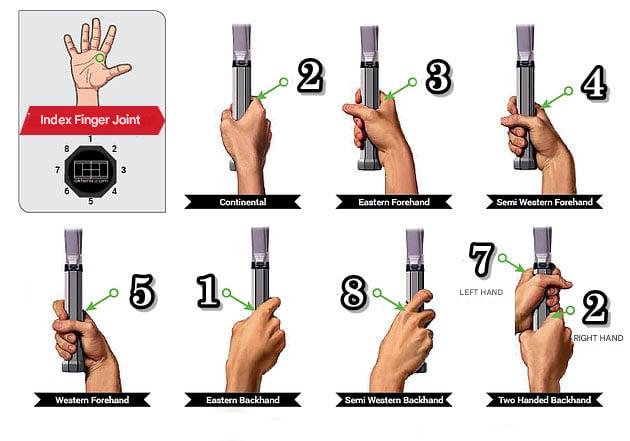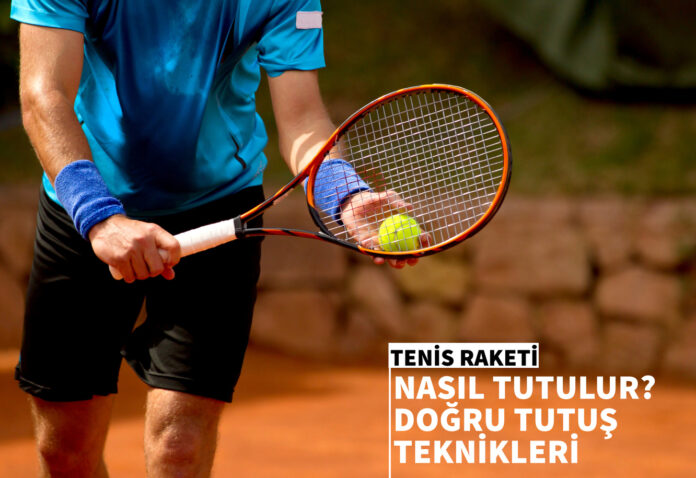Tennis is a popular activity that develops physical and mental skills. After acquiring the appropriate equipment, the next step is learning how to properly grip a tennis racket . For those new to tennis, the grip is one of the fundamentals of the game, and a correct grip will ensure a comfortable grip with every shot.
New players are often introduced to a single grip, making it easier for them to adapt to the game. It’s important to adopt a grip that feels comfortable to you from the start, as this will improve your ability to control the ball over time. Proper grip techniques not only improve your strokes but also reduce the likelihood of injury.
Before delving into the topic of grip, let’s review the different stroke techniques in the game of tennis.
Slice: This technique involves slicing the ball quickly from top to bottom. It’s often used effectively against balls that come in low to the ground and at high speed.
Forehand: A technique used to hit the ball from one side with the right hand, from the boundary line (endline) at the back of the court. For left-handed players, this stroke is executed with the left hand when balls land on the left side of the court.
Top Spin: Generally, this refers to the forward rotation of the ball as it leaves your racket. It’s the most commonly used stroke technique in tennis. This stroke uses less power, but achieves greater distance and speed. Top rotation can be used with forehands, backhands, and serves.
Backhand: An alternative tennis racket grip used on the back line. It’s used to return balls coming onto the court from the opposite side of the forehand. The backhand can be played with either one or two hands. Roger Federer is an example of a one-handed forehand, but most tennis players prefer a two-handed backhand.
A right-handed player uses a two-handed backhand, holding the racket with both hands and moving it to the left to hit the ball. A left-handed player uses the opposite technique, returning the ball to the right.
Volley: A stroke performed by moving the racket downward and forward without lifting the ball. It’s often used near the net. One of the most impressive examples of this technique can be seen in the matches of renowned tennis star Serena Williams.
After briefly reviewing tennis shots, we can discuss racket grip techniques.
Tennis Racket Grips Continental, Eastern, Semi Western and Full Western

Continental Grip
The Continental grip, one of the oldest grips in tennis, has survived from the era of wooden rackets to the present day. It’s the first grip recommended for beginners, especially adults. There are two main reasons for this:
- It is ideal for baseline shots (forehand and two-handed backhand) and offers comfortable use.
- The racket is easy to control, thus minimizing the risk of injury.
The continental grip is applied as if gripping a hammer. If you observe how professional tennis players hold their rackets when returning serves, you’ll see that many prefer this grip. This is because it makes transitioning to other grips easier.
Advantages:
- It can be used for forehand and two-handed backhand shots.
- It is effective in serve, slice and volley shots.
- It provides an advantage in net-front shots and allows you to easily receive low balls.
Disadvantages:
- It is difficult to produce a topspin shot, so it is not preferred at the professional level.
Eastern Tutus
Eastern Forehand
As the speed and intensity of tennis have increased, players have begun to favor the Eastern grip for more competitive and aggressive shots. Roger Federer is one of the most prominent representatives of this grip.
The Eastern grip is performed by holding the racket as if shaking hands. It’s an ideal starting point for learning the forehand stroke. It provides an advantage with topspin and flat shots.
Advantages:
- Facilitates topspin and flat shots.
- Effective on slice hits.
- Easy to switch to other grips such as the Continental grip.
Disadvantages:
- May be difficult to use consistently during long rallies.
Eastern Backhand
It is still popular because of its balanced performance on topspin, slice and straight shots.
Semi-Western Tutus
Semi-Western Forehand
It’s one of the most popular grips today, used by tennis players like Andy Murray and Rafael Nadal. It’s ideal for those who want to generate more topspin than the Eastern grip.
Advantages:
- It allows to generate topspin naturally.
- Makes it difficult for the opponent to receive the ball.
- Increases the percentage of balls landing on the court.
Disadvantages:
- It is difficult to counter low balls and slice shots.
Semi-Western Backhand
Suitable for topspin-heavy games.
Full Western Grip
It’s the most difficult grip for beginners, but it’s also known to produce the most topspin. It’s a popular choice for clay-court players.
Advantages:
- Provides the opportunity to receive high balls comfortably.
- It is the most effective grip for generating topspin.
Disadvantages:
- Low balls are difficult to counter.
- It is not effective on fast courts (grass and hard courts).
- It is not used in serve and volley shots.
To use the Full Western grip effectively, you need to fine-tune your position and contact point with the ball. If your reaction time is slow or you don’t have enough time, you risk losing points with this grip. Jack Sock and Kei Nishikori are among the players who use this grip.
Choosing the Right Grip
Professional tennis players don’t always follow standard grips exactly. For example, Novak Djokovic uses a grip that’s somewhere between a Full Western and a Semi Western.
To choose the right racket grip:
- First, do wall training (3-4 sessions) to determine which grip you are comfortable with.
- Then practice with your partner and test different strokes.
- Don’t forget to change your racket grip position according to each stroke.
To get the best results, you should choose the grip that best suits you and is most comfortable when training. The right grip can both improve your performance and elevate your game!



